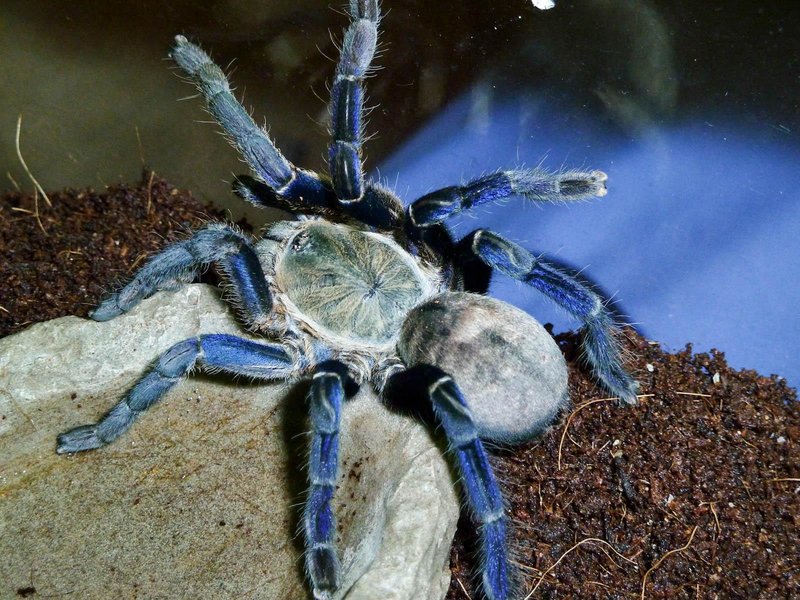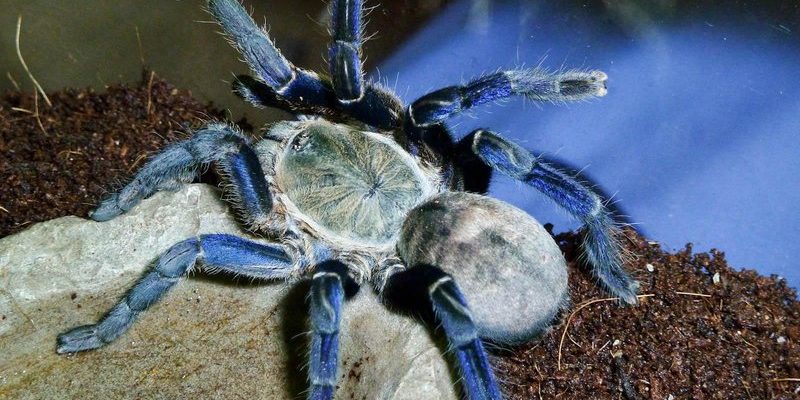
These colorful critters, scientifically known as Haplopelma lividum, are native to Southeast Asia. Their vibrant color is eye-catching, but there’s so much more to them than just their looks. Think of them like the rock stars of the tarantula world—bold, flashy, and full of personality. But before you decide to bring one home as a pet, there are some essential facts and insights you should know. Let’s explore the fascinating traits, habitat, and behaviors of the Cobalt Blue Tarantula!
Physical Characteristics: A Spider That Dazzles
One of the first things you’ll notice about the Cobalt Blue Tarantula is its stunning appearance. These spiders are not just blue; their vibrant hue changes depending on the light. Imagine how it would look under both bright sunlight and dim light—it’s a beautiful sight! Their body can reach up to 5–6 inches in size, making them one of the larger tarantula species.
The blue coloration comes from the tiny scales on their exoskeleton. These scales reflect light in a way that creates that dazzling effect. Besides their impressive color, they have long, hairy legs and a robust body, which makes them quite a sight. However, that beauty doesn’t come without a warning; their fangs can deliver a painful bite if provoked. So, it’s best to admire their beauty from a safe distance!
Natural Habitat and Distribution
Cobalt Blue Tarantulas are primarily found in the rainforests of Thailand, Myanmar, and surrounding regions. Their natural habitat consists of humid and moist environments, which help them thrive. Imagine living in a lush green jungle filled with tall trees and vibrant plants; that’s where they call home!
These spiders typically dig burrows in the ground to create a safe haven away from predators. The burrows are lined with silk, adding extra protection and comfort. Honestly, these spiders are not just sitting around. They’re busy creating a cozy nest while also being active hunters. They can be found lurking near the entrances of their burrows, patiently waiting for prey to pass by.
Behavior: The Bold and the Shy
When it comes to behavior, Cobalt Blue Tarantulas are a bit of a mixed bag. They are known for being *defensive* rather than aggressive. If they feel threatened, they might show off their beautiful coloration and even flick hairs as a warning. This is their way of saying, “Back off!”
On the flip side, these tarantulas are also incredibly active hunters. They prefer to ambush their prey rather than chase it down. Their diet mainly includes crickets and other insects. Picture them poised at the entrance of their burrow like a cat ready to pounce—that’s how they operate!
If you’ve ever wondered how they hunt, here’s the thing: they can sense vibrations in the ground, allowing them to know when something is lurking nearby. It’s like having a sixth sense, which makes them skilled predators.
Caring for a Cobalt Blue Tarantula as a Pet
Thinking about adding a Cobalt Blue Tarantula to your collection? First off, it’s crucial to do your research. These spiders require a specific environment to thrive. They need a terrarium that mimics their natural humid habitat, with plenty of substrate for burrowing.
Here are a few tips for creating a suitable habitat for your new arachnid friend:
- Humidity: Keep the humidity levels around 70–80%.
- Temperature: Maintain a temperature of 75–85°F.
- Space: Provide a spacious terrarium with substrate deep enough for burrowing.
Also, remember that handling them may not always be the best idea. They can be skittish and may bite if they feel threatened. So, it’s generally better to admire them from afar.
Life Cycle: From Baby to Beautiful
Like many spiders, the life cycle of the Cobalt Blue Tarantula is fascinating. It begins with an egg sac that a female produces after mating. Think of the sac like a tiny incubator, containing between 50 to 100 eggs. These eggs eventually hatch into spiderlings, which are mini versions of adults but lack the striking blue color initially.
As they grow, these spiderlings will molt several times. With each molt, they become more vibrant, gradually showcasing their iconic cobalt hue. This process can take a couple of years before they reach full maturity, which is when their beauty truly shines through.
What’s interesting is that as they mature, their behavior can also change. Adults tend to become more territorial, establishing their own domains. So, if you’re in the market for a tarantula, be prepared to observe these fascinating life stages!
Fun Facts: The Quirky Side of Cobalt Blue Tarantulas
Now, let’s wrap this up with some fun tidbits that make the Cobalt Blue Tarantula even more interesting:
- Color Change: Their color can vary; younger spiders may appear green or brown before turning blue.
- Defensive Skills: When threatened, they can launch tiny, irritating hairs from their abdomen, which can cause mild skin irritation.
- Longevity: With proper care, they can live anywhere from 10 to 20 years, making them a long-term commitment.
If you ever have the chance to see one in person, don’t miss it! Their unique features and behaviors make them a highlight for any spider enthusiast.
Closing Thoughts: A Jewel of the Arachnid World
The Cobalt Blue Tarantula is much more than just a pretty face. From its vibrant colors and unique behaviors to its specific needs as a pet, there’s a lot to appreciate about this remarkable spider. Whether you’re considering caring for one or simply enjoying learning about them, these tarantulas are jewels of the arachnid world. Remember to respect their space and understand their needs; they’ll reward you with years of fascination and wonder.

